What Are Holons - Understanding Holism - Part 1
Great fleas have little fleas upon their backs to bite 'em.
And little fleas have lesser fleas, and so ad infinitum. - The Siphonaptera
- Introduction to Holism and Holistic Thinking : Leo introduces the concept of holons as a foundational element for understanding holism and holistic thinking. The more practical aspects of this idea will be elaborated in part two of the series.
- Origins of the Concept of Holons : The term “holon” was coined by Arthur Koestler and later expanded by Ken Wilber, implying that reality's fundamental building blocks are these holons which are simultaneously parts and wholes.
- Nature of Holons : Holons can be physical objects like cells or even abstractions and mental objects. Reality consists of a nested hierarchy of holons, from subatomic particles to the entire universe.
- Perspectival and Relativistic Aspect of Holons : The perception of holons is relativistic, varying based on the chosen perspective. Every object can be seen as a holon depending on context.

- Interpenetration of Holons : Holons can be part of multiple other holons and interpenetrate each other. For instance, a person is part of various holons such as a family, a country, and the human species.
- Complexity of Holonic Design : Complex systems demonstrate modularity, allowing for a component-based structure that facilitates repair and understanding. Examples include the human body’s organ transplants and the interchangeable parts of a car engine.
- Complexity of Reality : Leo emphasizes the incredible complexity of reality and the importance of understanding this complexity for accurate manipulation, such as repairing a car or performing medical procedures.
- Appreciating Complexity in Spiritual Contexts : In spiritual circles, there is often an oversimplification of reality. However, Leo argues for a deeper appreciation of the staggering complexity inherent in all aspects of reality.
- Complexity of Reality : Reality's complexity is astounding, from intricate systems like car engines and computer processors to the vast ecosystem of our planet, encompassing everything from the atmosphere to the brains of billions of living beings.
- Interactions of Holons : Holons interact in multilayered ways that are not simply bottom-up, but also top-down and sideways, leading to a dynamic and complex interplay that necessitates a multi-dimensional understanding.
- Examples of Holons : Examples include computers, software like Windows operating system, sports teams, cities, political parties, nations, fisheries, economies and industries, coral reefs, and even the human body, which can be likened to a city based on its functional complexity.
- Nature of Holons : According to Wikipedia, holons are self-regulating, self-organizing structures that balance chaos and order, existing as discrete yet interconnected entities, ranging from subatomic particles to the multiverse.
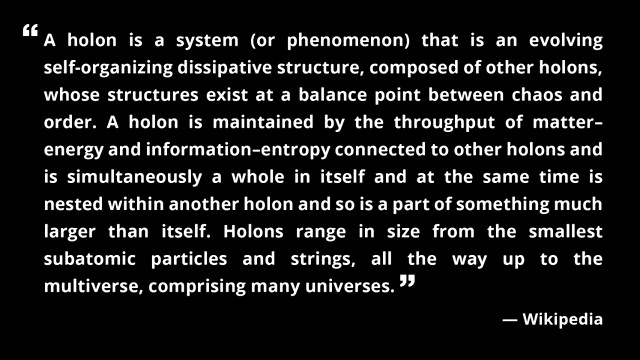
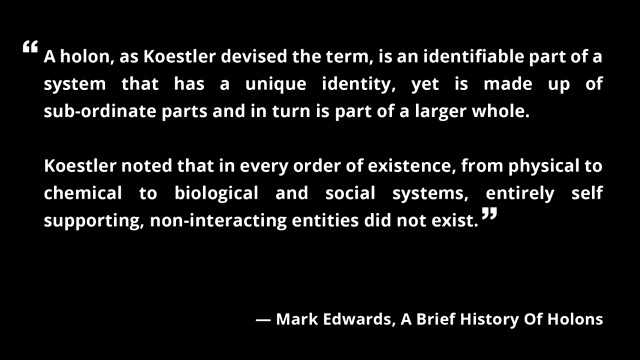
- Autonomy and Community in Holons : Holons demonstrate a balance of autonomy and community, with the capacity for self-reliance and independence, yet simultaneously under the influence of larger systems that they also influence.
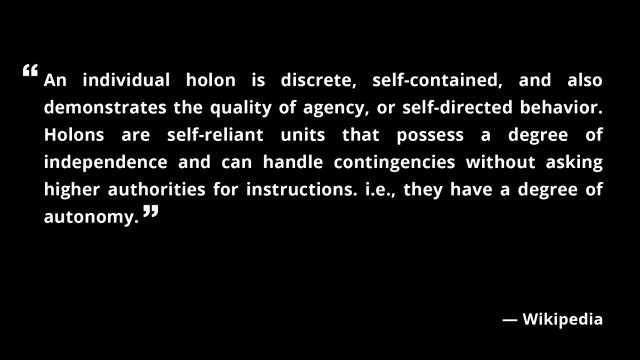
- Complexity and Creativity in Holarchy : Holons become increasingly complex and creative up the hierarchy, gaining more degrees of freedom and capabilities, from simple molecules to complex societal structures.
- Bi-directional Information Flow in Holons : Information within holons flows both ways—from the macro to the micro and vice versa—and is crucial to the stability of the system. When this flow is compromised, systems like biological organisms can break down, analogous to cancer.
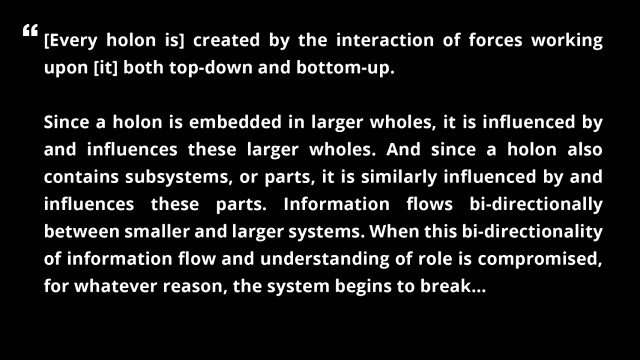

- Order and Balance in Biological Systems : The human body exemplifies the delicate balance required to maintain life, surviving for decades despite various abuses, signifying the intricate order necessary for complex systems to function.
- Fragility and Complex Balance of the Human Body : Even minor dysfunctions in the body highlight the delicate balance necessary to maintain health. Every cell has a role, from respiration to immune responses, and the body's complexity is evident in these interactions. The sheer number of cells and how they differentiate between helpful and harmful bacteria emphasize the importance of holons in our biological system.
- Engineering Lessons from Biological Systems : Studying the body's ability to manage complexity and harmony can provide insights for designing efficient social systems, cities, sports teams, corporations, and organizations like the UN.
- Nature's Genius in Design : By not taking nature for granted and examining the human body's design, we can gain incredible insights into stability, complexity, and harmony which could improve human-designed systems.
- Holarchy vs. Hierarchy : A holarchy is a hierarchy without a definitive start or end point, suggesting an infinite structure. This concept is contrasted with traditional hierarchies, challenging the way we structure and understand reality.

- Interconnections within the Web of Life : Reality comprises networks within networks, with no clear hierarchies or linear structures. This networked nature of existence emphasizes the limitless, nested connections within the universe.
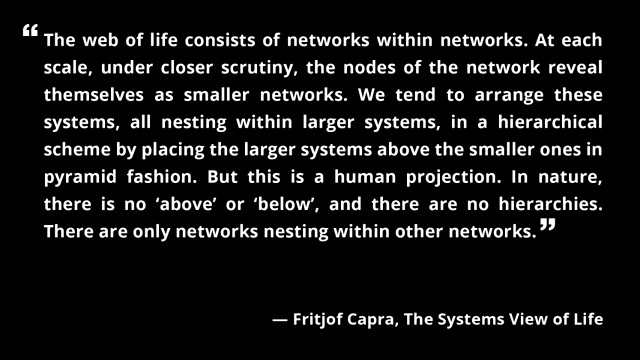
- Understanding Organizational Structures : Rethinking organizational structures away from strict hierarchies towards more holistic and interdependent holarchies could result in healthier, more balanced systems.
- Limitations and False Impressions of Control : The illusion of a central ego or CEO governing the body underscores the misconception that control is strictly top-down, where, in reality, many functions are autonomous, demonstrating a need for nonlinear understanding.
- Redefining Parts and Wholes : The concept of parts and wholes is subjective, based on perspective. Misidentifying these can lead to problems in society, governance, and design.
- Problems with Overemphasis on Community or Individuality : Political ideologies like those in authoritarian regimes or libertarian philosophies can be unsustainable when they focus too heavily on the collective or individual at the expense of balance.
- Designing Healthy Systems Requires Balance : Crafting well-coordinated societies requires understanding the balance between individual autonomy and collective responsibility, aiming for utility without oppression.
- Reflection on Libertarianism and Unsustainable Systems : Extreme libertarianism in the United States disregards societal responsibilities, risking sustainability. Leo criticizes this philosophy and underscores the importance of a balanced approach for durable societal structures.
- Societal Design Faults : Unconscious design within society leads to negative outcomes like school shootings, pollution, criminality, drug abuse, war, genocide, and racism. These consequences emerge primarily due to the lack of holistic consideration in societal structures.
- Harmony in Holistic Design : A more holistic design accounts for the harmony between parts and wholes and balances different levels of interaction. Such designs create and sustain complex and efficient systems, comparable to the human body.
- Sacrifices for Unified Action : Coordination and unified action across holons require individual parts to sacrifice some autonomy. Analogous to a cell in the body obeying the commands of the brain, individuals must conform to the broader rules of social holons like family, community, and society.
- Cultural Programming and Rules : Most cultural norms and prohibitions are absorbed unconsciously from an early age. People often follow these without deep consideration, though not all cultural rules may be beneficial or healthy, exemplified by the libertarian philosophy on gun control.
- Complex Social Interaction : Individuals must navigate between their personal freedom and the requirements of the larger social structures they are part of. The challenge lies in achieving a sustainable balance that avoids the extremes of absolute freedom or oppressive tyranny.
- Corporate Regulation and Social Balance : There is inadequate regulation over corporate power, leading to problems like predatory capitalism. Achieving the right balance between corporate freedom and social welfare is a complex task requiring wisdom.
- Responsibility in Social Constructs : Humans are tasked with creating harmonious societies, an undertaking that mirrors the marvel of the human body created by the universe. Sensible sacrifices and exploitation avoidance are essential for a balanced collective existence.
- Avoiding Dysfunctional Sacrifice : Individuals should resist participating in dysfunctional collective actions, such as unjust wars, and be mindful of ethical implications before committing to collective decisions.
- Misunderstanding of Control in Power Structures : Contrary to conspiracy theories, no small group fully controls complex systems like governments. Instead, power is distributed in a circular causal manner, with elected officials being empowered by the people's choices.
- Individual's Role in a Complex Society : It is vital for individuals to recognize their integral role within societal holons, maintain their responsibility, and not blindly follow collective madness that can manifest in negative outcomes like war and discrimination.
- Balancing Laws with Higher Order : While certain social rules are necessary for societal order and functionality, balance with the higher order aims of society is essential, and compliance must be grounded in understanding rather than forced obedience.
- Circular Causal Chains : To understand societal and governmental structures, one must appreciate the complexity of circular causal chains. This perspective challenges oversimplified conspiracy theories about centralized control by the powerful elite.
- Delusion of Centralized Control : Conspiracy theories suggesting that a handful of individuals such as billionaires or secretive groups control the world are considered delusional. Real power structures are far more intricate and interwoven than such simplistic views allow for.
- Source of Power and Responsibility : Power structures derive their legitimacy and resources from the public. For instance, consumer transactions with companies like Amazon directly contribute to the wealth and influence of figures like Jeff Bezos. Recognizing this highlights the shared responsibility each individual holds in shaping power dynamics.
- Government and Self-Reflection : Criticizing one's government without recognizing one's own participation and responsibility in its formation creates a false duality. To improve societal structures, one must include oneself in understanding the complex, multi-dimensional and circular nature of social systems.
- Holons and Ego : Realizing that one is part of larger holons requires humility and letting go of ego. Individual parts of a system must work selflessly for the greater good, just as the organs in a body function to preserve the whole organism.
- Selflessness in Holons : For a harmonious system, individual holons need to exhibit humility and selflessness, contributing to the well-being of the larger system without self-centered motivations.
- Laws and Community Survival : Obeying societal laws, such as paying taxes, is essential for maintaining vital services and structures. Cheating on such responsibilities can lead to the degradation of community well-being.
- Foundations of Holistic Thinking : Leo indicates the upcoming discussion in "Holistic Thinking - Part 2," which will explore how to apply a holistic approach to design and social engineering, emphasizing that social engineering is mistakenly viewed negatively when it could be crucial for systemic improvement.
- Life's Delicate Balances : The dilemma of life involves finding delicate balances between autonomy and community, individualism and collectivism. This complex process cannot be reduced to simple formulas and requires conscious effort and self-development.
- Masculine and Feminine Dynamics : The masculine and feminine tend to value autonomy and community differently, leading to unique challenges in relationships and societal roles. A better understanding of these dynamics can aid in finding balance and avoiding pathologies related to overcommitment or excessive detachment.
- Political and Social Simplifications : Simplistic binaries like capitalism versus socialism or individualism versus collectivism fail to capture the complexities of societal structures. Higher, more nuanced and holistic perspectives are needed to transcend these limitations and foster better systems.
- Gender Dynamics in Holonic Understanding : Leo discusses the complicated nature of understanding attraction between males and females, citing that this often leads to demonizing the opposite sex. He emphasizes the importance of recognizing that humans are not the apex holon in the universe, warning against narcissistic behaviors that lead to self-centered views and suffering in the world.
- Cultural Acknowledgement of Human Limitations : Leo suggests that a solution to humanity's issues lies in culturally acknowledging that humans are not the highest holon and that humility is needed. He argues for a necessity to make sacrifices for the overall ecosystem of the planet and to prepare for cooperative interactions with extraterrestrial life forms in the future.
- Concept of Indra's Net : Leo introduces the concept of Indra's Net from Hinduism and Buddhism, which explains the universe as an intricate web of mirrored orbs. Each orb reflects every other orb, pointing to the interconnectedness and non-linear relationship among all holons.
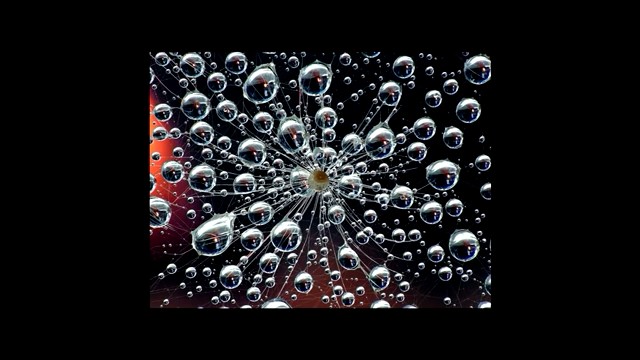
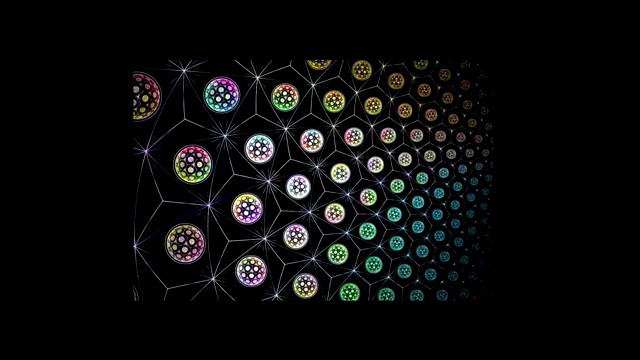
- Fractality and Interpenetration of Reality : Quoting ancient texts, Leo illustrates the fractal, recursive, and interpenetrative nature of reality, where everything is deeply connected as part of a whole. This concept of infinite interpenetration aligns with the idea of holism being a fundamental part of existence.
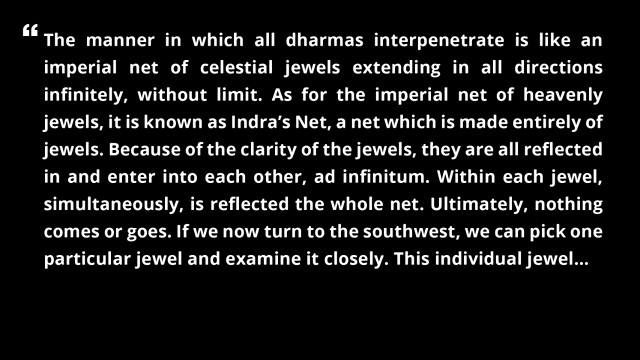
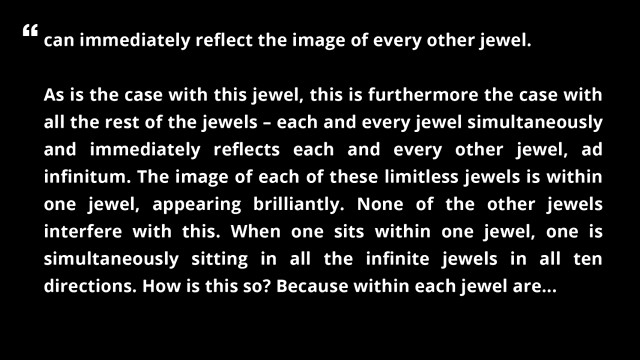

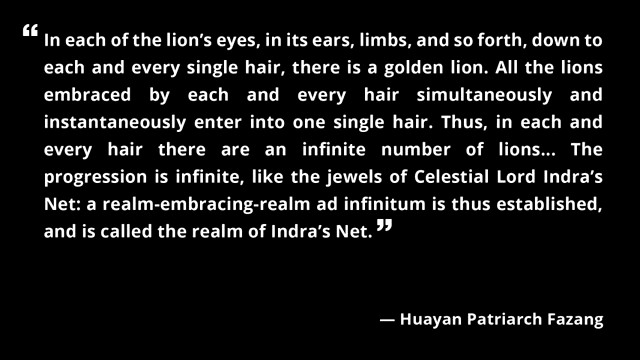
- Consciousness Beyond Materialism : Discussing his psychedelic experiences, Leo claims that everything, including the human body, is made of consciousness. He shares personal insights on seeing all entities within his own hands, leading to the conclusion that reality is a fluid hallucination shaped by consciousness.
- Reality's Groundlessness : Leo emphasizes that reality lacks a foundational ground, rejecting notions in science, religion, and philosophy that attempt to anchor reality in specific entities. This realization may cause existential discomfort, but it is crucial for understanding the structure of existence.
- Reality's Infinite Imagination : Leo proposes that reality's true nature is to imagine itself into existence infinitely. This infinite creative potential makes reality groundless, holographic, and a fractal mindscape where all is interconnected.
- Indra's Net as a Metaphor for Understanding Reality : Leo suggests using the image of Indra's Net as a lens to view the universe, replacing outdated materialist views with an understanding that reflects the non-linear and deeply interconnected nature of holons.
- Groundlessness of Reality : Reality is described as groundless, with no fixed anchor point like atoms, brains, or historical events. Leo contends that the very need for a ground limits reality and thus, reality would not confine itself in such a manner.
- Ego's Search for Ground : The ego seeks to ground itself in tangible concepts such as a brain or atoms to maintain a sense of reality and existence, but this grounding is imaginary and merely a mental construct.
- Historical Grounding as Imaginary : Leo challenges the conventional idea of grounding one's existence in historical lineage, highlighting that concepts like birth, ancestry, and even the Big Bang were all invented after one's birth and are, therefore, imaginary.
- Infinite Imagination : Leo proposes that reality is not restricted by any fundamental components but is rather an expression of infinite imagination, capable of envisioning any scenario without limitation.
- Reality as an Infinite Holographic Fractal Mindscape : Leo introduces the concept of reality as an infinite holographic fractal mindscape, where each part contains the whole and consciousness is infinitely capable of imagining any part of the universe independently.
- Clarifying Holography : Leo explains what true holograms are, how they preserve the whole image regardless of damage, and likens this to consciousness, which is also infinitely holographic, encompassing and imagining every part of the universe.
- Infinite Nature of Consciousness : Reality and its elements—energy, atoms, space, and even human bodies—are described as inventions of consciousness, which itself is an infinite and self-imagining entity without confines.
- Reality Without a Ground : The search for a 'ground' or foundational basis for reality is dismissed as a futile pursuit, with Leo asserting that reality itself is infinite, without a clear starting point or ground.
- Infinity as Magical Reality : The notion of infinity is presented as magic, making the impossible possible, allowing the universe to exist and create itself with infinite power, defying the rules of logic.
- Creation & Existence: For anything to exist, including a single atom, infinite power is necessary. This concept challenges traditional scientific and materialist perspectives which are often in search of a finite ground for reality.
- Unraveling the Infinite Fractal : Our search for the origins of the universe is described as unraveling an infinite fractal, with reality constantly expanding its backstory in response to our inquiries.
- Backstory as Imagination : The backstory of where everything comes from, including our own existence, is imagined by us as we probe reality, seen when looking in a mirror or exploring space.
- Infinite Backstory and Consistency : Leo likens the infinite backstory of reality to an author who can keep inventing history for a character endlessly, maintaining internal consistency.
- Grasping the Infinite Whole : Enlightenment involves grasping the entirety of the infinite reality as a whole, recognizing oneself as God who is creating themselves, and acknowledging the groundless nature of existence.
- Ultimate Holon as Self : The highest holon is not the physical universe but the individual's own consciousness, with everything occurring within oneself, revealing a truth that is often hidden by perceiving oneself as finite.
- Reality as Unity Through Infinite Subdivision : Reality is explained as unity that can subdivide itself infinitely, creating an interconnected fractal reality where the highest holon is the self or God.
- Practical Holonic Observation and Care : To apply holonic understanding, one must acknowledge the interconnectedness of everything, see beyond personal concerns to care for larger wholes, and care for the various parts within oneself, creating internal harmony.
- Holistic Love and Non-Judgment : Avoid conflict, judgment, and dismissal of different parts of reality as it undermines the embodiment of god consciousness and leads to a devilish separation from the whole.
- Hallarchic Tapestry : Reality should be viewed as a holarchic tapestry of interconnectedness and circular causations, acknowledging that individual actions have reverberating impacts throughout the whole system.
- Reverberation of Actions : Everyday actions, such as eating fast food, have complex implications beyond personal health, impacting economic and global health by contributing to the proliferation of unhealthy choices.
- Balancing Judgment and Compassion : While recognizing the negative impacts of certain actions is important, demonizing or cutting off parts of reality creates imbalance and a lack of love and compassion for those involved.
- Life Devoted to Universal Good : Ponder what life would be like if every action was dedicated to serving the universe's highest good, without oppressing any parts, in order to align with the principles of holistic living.
- Anticipation for Holistic Thinking : Stay tuned for part two, "Holistic Thinking," which promises to offer practical illustrations and foundational knowledge for a more appropriate understanding of varied anecdotes.